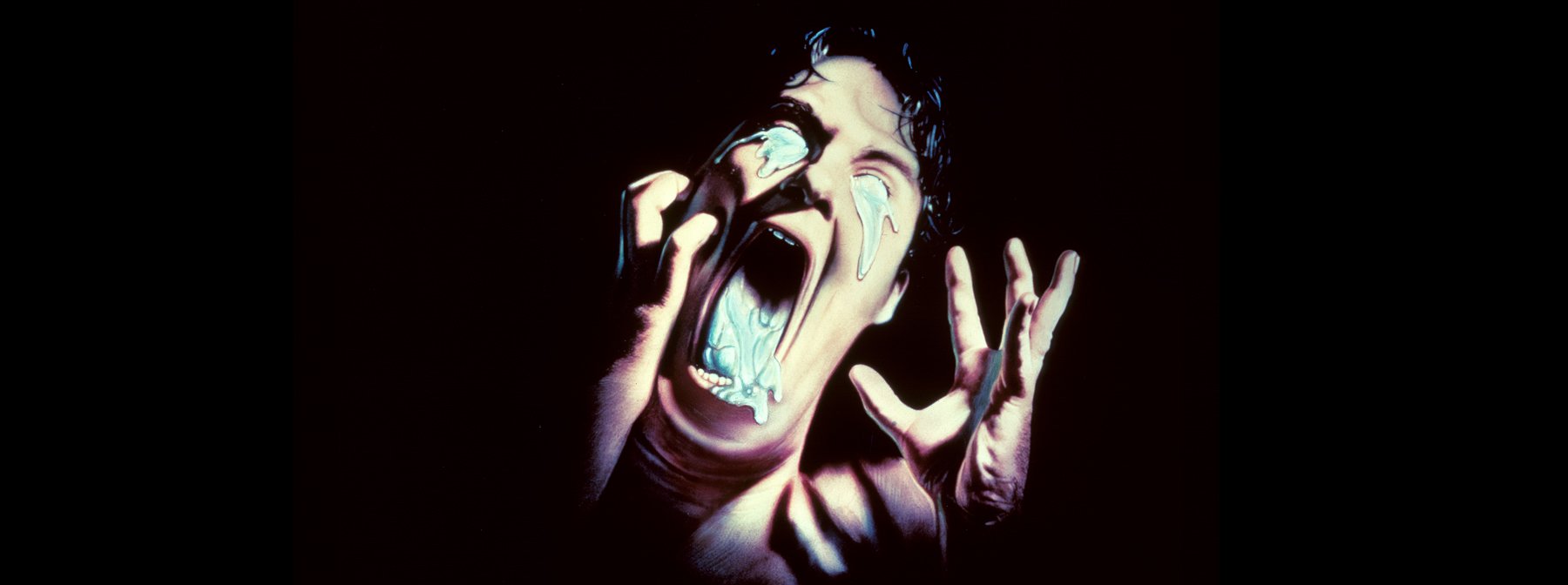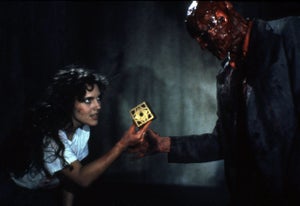
It fell to Earth inside a meteorite, oozed its way through a small Pennsylvania town, and helped launch Steve McQueen’s career. It could only be 1958’s The Blob. While the film has inspired dozens of imitators and devotees, The Blob is far from the only blob monster movie – it wasn’t even the first! Dozens of other horror and science fiction films have offered their own oozing creatures, embodying myriad fears and ideas. From corrupting alien forces to horrors close to home, join me as we explore five different blob monster movies.
X the Unknown (1956)
In 1955, Hammer Films saw great success with The Quatermass Xperiment, an adaptation of Nigel Kneale’s BBC serial of (almost) the same name. The follow-up would concern a lump of radioactive slime bubbling up from a fissure in rural Scotland. Hammer approached Kneale to use his Quatermass character, but he refused. Nevertheless, Hammer pressed ahead, and X the Unkown became a standalone – and standout – entry in the company’s ‘50s filmography.
Unlike Hammer’s Quatermass films, which concern hostile alien visitors, X the Unknown looks inward; the monster emerges from the depths of the Earth. Radiation is a primary concern like in many of its genre contemporaries, but unlike those films, the threat of radiation is rendered in an arguably more realistic manner. The horrors of radiation are literally presented via radiation sickness – the victims of which include a young child. This is emphasised by the remote domestic setting; the film takes place in a small village, not a major metropolis. Fears of radioactivity are brought into the intimacy of domesticity, where they are most potent.
X the Unknown is also a striking example of how several of the most graphic monster films of the 1950s featured blob monsters, from The Blob itself to Toho’s The H-Man (1958). Flesh bubbles and melts as the creature’s intense radiation destroys anyone who gets too close.
https://www.youtube.com/watch?v=krz8ym_TdSs&pp=ygUVeCB0aGUgdW5rbm93biB0cmFpbGVy
Quatermass 2 (1957)
As The Quatermass Xperiment played in UK cinemas, Kneale’s Quatermass II serial debuted on television. Finally, Hammer was able to produce a proper Quatermass follow-up, quickly seeking the rights to adapt Quatermass II into a film. Kneale himself penned the first screenplay draft; director Val Guest later contributed his own refinements. Quatermass 2 sees meteorites bringing an alien menace to Earth which quickly infiltrates the British government. The invaders establish a mysterious food processing plant near the rural Winnerdon Flats, the giant domes of which hide the shapeless creatures within.
Though the film presents an extra-terrestrial invasion, it more pressingly depicts the British government as already under capture – eager to enforce loyalty, silence, and conformity by military means. In turn, the British government effectively becomes the invader, displacing and exploiting the locals of Winnerdon Flats to construct the means of its own reproduction and survival. The film’s climax sees the workers of the village rise collectively to fight back, making Quatermass 2 both exceptionally political and one of the standout invader narratives of the 1950s.
The film’s execution confidently delivers its political intrigue, with low-angle shots of the plant achieving both eerie discomfort and a suggestion of industry itself as a tool of conquest. The blob monsters themselves only really appear at the film’s climax, but it’s worth the wait. They are a triumph of special effects, beautifully framed amongst detailed miniature sets. These towering, shapeless, slimy things deliciously embody the idea of a corrupt state interested only in its own existence, defying description in their monstrosity.
https://www.youtube.com/watch?v=vCwRzJQ0T7Y&pp=ygUZcXVhdGVybWFzcyAyIDE5NTcgdHJhaWxlcg%3D%3D
Caltiki, the Immortal Monster (1959)
Caltiki, the Immortal Monster is a striking Italian entry in the blob monster canon, taking its cues from Hammer’s X the Unknown and Quatermass films. Opening narration tells us that in 607AD, the Mayans left their civilisation to escape the wrath of a violent goddess, Caltiki. In the present, a team of archaeologists finds a sacrificial pool in the Mayan ruins, overseen by a menacing statue of Caltiki. When the bodies at the bottom of the water are desecrated, a shapeless mass emerges. Caltiki has returned.
Directing duties for Caltiki can broadly be ascribed to Ricardo Freda and Mario Bava. The specifics of their involvement vary depending on whose testimony you listen to. In a 1971 interview with Luigi Cozzi, Freda said that although he directed it, it was “Bava’s type of film”. Meanwhile, Massimo De Rita, who worked for Galatea (the film’s production company) at the time as a unit manager, said that Bava directed 90% of the picture. Caltiki certainly sits comfortably alongside Bava’s other black-and-white genre offerings like Black Sunday (1960).
It is colonial greed that reawakens Caltiki. The researchers intrude upon and misunderstand the ancient Mayan culture which first named and tried to rationalise the creature. In an illuminating moment, one of the team is told not to interfere with a local dance ritual done to placate the spirits. Despite being specifically told that a white man joining in will bring bad luck, the man scoffs and does so anyway. It is his flesh that Caltiki devours first.
Caltiki’s appearance in the 20th century is immediately shocking in its gruesome violence, but also because its cyclical arrival (activated by radiation from a passing comet every 1,352 years) suggests it will remain where we (read: modernity) fall away. After all, the “immortal” creature already witnessed the appearance and disappearance of the Mayans. Its reliance on radiation may seem like a perfunctory use of contemporary atomic fears, but what might nuclear proliferation bring in a world where Caltiki’s return is assured? It marries modern anxiety with ancient malevolence in an interesting manner.
https://www.youtube.com/watch?v=FG3qxVlvFss&pp=ygUcY2FsdGlraSB0aGUgaW1tb3J0YWwgbW9uc3Rlcg%3D%3D
The Green Slime (1968)
This US-Japan co-production between MGM, Ram Films and Toei sees Robert Horton tasked with blowing up an asteroid on a collision course with Earth. He ascends to the Gamma-3 space station, from which he and the crew travel to the asteroid to plant explosives. Although their mission is successful, they accidentally bring back a speck of green slime. When exposed to energy, the slime becomes a legion of tentacled, cycloptic monsters. The creatures bleed more of the green ooze when attacked, increasing their number and contaminating the station.
In an interview for Filmfax magazine, Horton remembered the film poorly but had nothing but praise for the Japanese crew – including director Kinji Fukasaku, known for his Battles without Honour and Humanity films also made for Toei. Horton recalled seeing the film in New York, describing how, “about three minutes before I knew the film was going to be over with, I said, ‘Let’s get out of here; I have no desire for anybody to see me.’ The picture was dreadful.” Horton’s views aside, The Green Slime has much to enjoy.
In one sense, the film is optimistic about the future. Space exploration, orbiting stations, and the prevention of otherwise catastrophic threats to Earth are rendered normal. On the other hand, the Green Slime themselves are the oozing, screeching fears of the unknown personified. Mankind has stepped into the wider universe, but it’s a universe filled with anxious possibility. That the film was released in the US not long before NASA put a man on the moon is interesting. As mankind ventured further into space in the present, The Green Slime offered an exciting vision of the future.
https://www.youtube.com/watch?v=mVvm8YMz6z0&pp=ygUcdGhlIGdyZWVuIHNsaW1lIDE5NjggdHJhaWxlcg%3D%3D
The Stuff (1985)
This list has plenty of blob monsters that eat people, but what about monsters that we devour?
From Larry Cohen comes The Stuff, a horror-satire about a yoghurt-like substance which bubbles up from the earth at a drilling site. After a man literally eats it right off the ground, its sweet taste is quickly packaged and sold; enter, “The Stuff”. But there’s something alive in this new treat – something that controls your mind, eats you from the inside, and then leaves your hollow carcass to find a new host. Young boy Jason (Scott Bloom), industrial spy “Mo” Rutherford (Michael Moriarty), and former Stuff publicist Nicole (Andrea Marcovicci) band together to stop the deadly menace.
To say The Stuff is about mass consumption is obvious (Cohen was open about his desire to satirise fast-food consumer culture) but the presentation is so wild it doesn’t lose potency. The quick pace highlights one of the Stuff’s most frightening aspects: how fast it takes over. We cut from the Stuff’s first appearance to Jason seeing it move in his fridge, by which point it’s already been sold in great quantities – the forces of capital moving faster than we can react. Notably, the various CEOs responsible for delivering the Stuff to consumers do not themselves consume it. Mental and bodily destruction is a socialised risk to maintain private profit.
Scholar Lea Anderson provides closer examination of the Stuff’s image, observing that it isn’t merely an embodiment of capitalism, but white capitalism specifically. Anderson notes that, “The aestheticization of the stuff as both sweet and white as snow...[subverts] the standard symbolism wherein white is associated with goodness and purity. Here, its milky sweetness ultimately masks its deadliness.” Indeed, in a resolution as steeped in satire as its crisis, the film posits a fascist militia to subdue the capitalist horror. In a witty moment, the group’s leader (Paul Sorvino as Col. Spears) asks Nicole to spruce up his public image. He makes a telling comparison between himself and the Stuff (“you sold that white shit, why not me?”) which cleverly draws attention to their similarities. A white lifeform, eager for mass control and violently destructive in its lust for self-preservation, versus the Stuff.
Having said that, not all the satire is successful. Much of the material involving Spears doesn’t work, and the film ends up with some horrendous racism as a result.
https://www.youtube.com/watch?v=e_ROA_ZEGfA&pp=ygUWdGhlIHN0dWZmIDE5ODUgdHJhaWxlcg%3D%3D
Blobbing Along...
Whether planning your own “Blob-A-Thon" movie marathon or just curious to add more slime to your watchlist, these five films are great places to start. With the cultural longevity of The Blob assured, branch out and enjoy these other oozing nightmares. From corrupt governments to mass consumption, myriad ideas have found form in the formless image of blob monsters.
Further reading:
Anderson, Lea (2022). Be(ware) The Swallowing: Goo Is Gonna Get You In The Blob And The Stuff. https://www.fangoria.com/original/beware-the-swallowing-goo-is-gonna-get-you-in-the-blob-and-the-stuff/ [Accessed 28/1/23]

Related Articles








